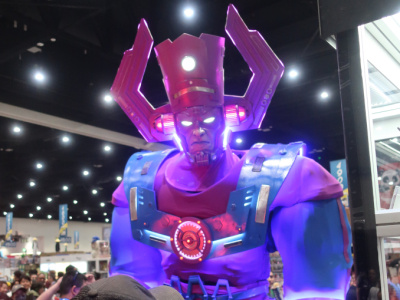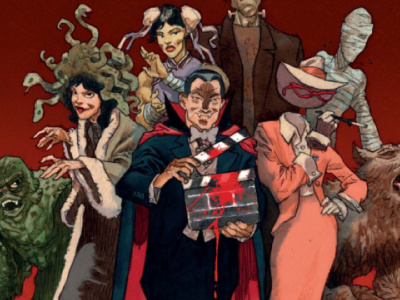
Can you comment on the difference between the CGI animation in the original 2004 Appleseed movie and in Ex Machina?
The first movie was the first major anime CG film and it was a pretty chaotic production. It was done in under a year from start to finish and the budget was a lot less than this one's was. Ex Machina had a budget that was three times as big and a lot more care went into it; even pre-production took about a year. In total it was about a two-and-one-half year project; including marketing, for me it was about three years. So with Ex Machina they had something to reflect upon and improve upon and they had more time and more resources.
In Japan the anime creators always try to outdo themselves with the next one and the one after that -- and in this case we had John Woo and we were trying to appeal beyond just the core of anime fans. All of those things worked together to achieve this kind of look. When you look at it, it's not a simple cel-shaded look, it's a balance between a cel-shaded and realistic look. I'm pretty happy with the look that Aramaki was able to achieve and hopefully it's something that fans will like as well.
With the success on DVD of Beowulf, which also uses a lot of motion-capture, and now with the strong start for Ex Machina is it too much to say that there's a new animation genre that appeals directly to gamers and a wider audience?
I think you're probably right. Actually we had an interesting brush with Beowulf -- we did a 3D test with Ex Machina with the team that actually did the 3D work for Beowulf, so they did a scene and it turned out beautifully, but the timing didn't work out to allow us to make the film a 3D theatrical release. But what I took away from that experiment was that like Beowulf, this is performance capture animation. It's not key frame animated, it's human movements that are being captured and shown on the screen. On Appleseed Ex Machina we had four different types of actors -- we had motion capture actors, we had stunt actors, we had facial movement actors and then we had voice actors. You have to blend all this with the artistry of the CG animation people to really create this new look and visual style. It definitely is a different process and it is a different genre in a way from traditional animation. In
If Ex Machina continues to do well on DVD will there be a third Appleseed movie?
Yeah, well there is going to be an announcement about a different Appleseed at the Tokyo Anime Fair, and I can't go into that until we announce it, but yes a third Appleseed movie is definitely a possibility once we see the performance of this film -- and hopefully not just Appleseed, but other titles as well.
More theaters will be equipped for 3D, so that will be part of the mix too, won't it?
I think that by 2010 there will be at least 10,000 screens in the
And, from what I've learned 3D is coming to home entertainment as well. It's going to take a little bit of time, probably 5-10 years to get the proper equipment out there, but it's definitely coming. So I think there is a new technology coming, there's a new delivery method coming, and content will have to evolve right along with it.
How did you market Appleseed Ex Machina in order to expand the audience to include the gamers and action film fans as well as the traditional anime audience?
While I was helping with the marketing on this, I tried to categorize and think who would be the audience for this film, and you're right. John Woo fans are one group, gamers are another and anime fans are the core. But also because this is a hi-def production and coming out on Blu-ray, the hi-def video enthusiasts are another. So we just tried to categorize the audience and then find the way to reach out to each specific group. In terms of reaching the John Woo fans, I think it was important that we highlight his involvement at screenings and film festivals that we've held around the country. And the most important outreach efforts were TV ads where we were trying to hit these groups directly and I think the TV ads were very successful. We were hitting different outlets -- we were hitting the Sci Fi Channel, Spike, and the Cartoon Network's Adult Swim. I think that Sci Fi Channel and Spike were instrumental in reaching out beyond the normal anime audience -- they're not the readers of anime magazines. TV spots were important, and having John Woo's name out there, and wherever possible at retail we wanted the film racked in the Action/Adventure section and the Blu-ray section as well as with the anime.







